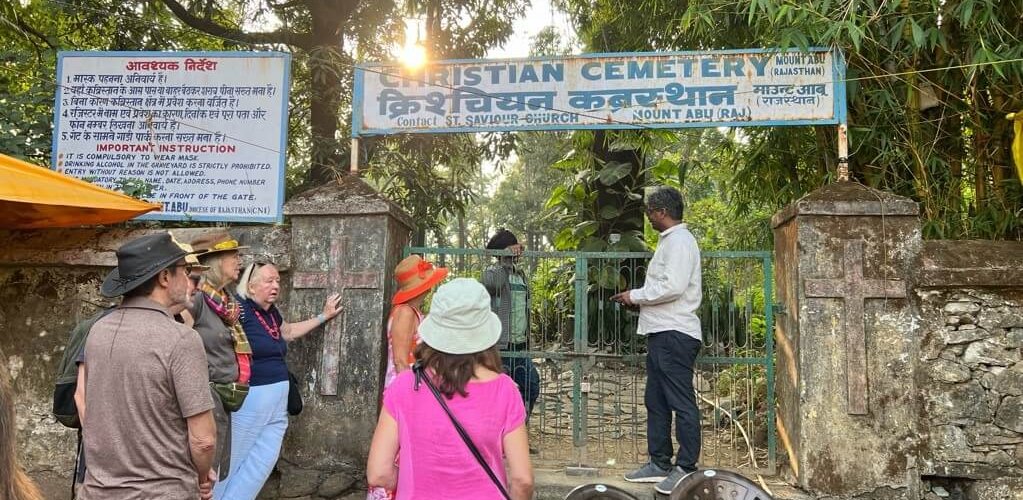News from the Second Tod Tour
The 2nd Tod Tour is well underway following in the footsteps of James Tod’s journey in Gujarat as described in his book Travels in Western India. You may remember Liz Driver’s lecture on October 4th which outlined the reasons for Tod’s dismissal as Political Agent in the Western Rajput States in 1822 after which he travelled to the west of Rajasthan through the Aravalli Hills and then south to Gujarat.

Day 1
After arriving in Udaipur from Mumbai, we began our journey from Gogunda, one of the sixteen great fiefs of Mewar and Tod’s first stop on his journey home.

We made our way to Sirohi where Tod was greeted enthusiastically by the young Rao Seo Singh. Tod had helped Sirohi defend itself against incursions from Jodhpur and the hill tribes. We were met there by the Maharaja’s brother Maharaj Sahib Daivat Singh Bahadur and the present Maharaja’s son, Maharajkumar Shri Indreshwar Singhji Sahib who accompanied us to the Sarneshwar Mandir built in 1526 and told us the story of its origins.
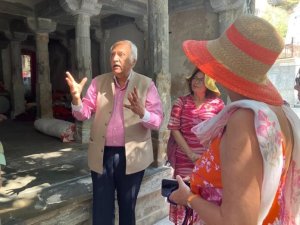
When Alauddin Khalji, Sultan of Delhi (1296-1316) invaded Gujarat in 1297 destroying many Hindu temples, he took the lingam from the temple of Rudra Mahalya at Siddpur in northern Gujarat. On his return to Delhi through Rajasthan, his army was attacked by Maharao Vijay Singh at Sirohi who had vowed to recover the sacred lingam. He defeated the Sultan’s troops and placed it in a sanctuary at the bottom of Siranwa Hill where the battle had taken place and where it can be found today. The temple is also known for the curative properties of the water from its spring. Alauddin annoyed by his defeat at Sirohi returned in 1298 to destroy the temple but the water from the spring cured his leprosy, so he vowed never to attack Sirohi again and built a wall around the temple.

We then visited the old palace and fort which is now unoccupied and is only used for special occasions. The wall paintings date from the 16th century and depict scenes from the Ramayana. Mirror work also decorates many of the rooms and restoration work has begun in several parts of the palace.

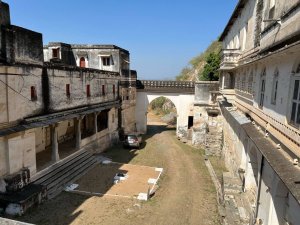
From there we went to lunch at the new palace built in 1911and met the H.H. Maharajadhiraj Maharao Shri Raghubir Singhji Sahib Bahadur and other family members. We presented the Maharaja with Tod’s map of Rajasthan and a book on the Indian paintings in the British Library. We were able to see a copy of the missing painting of Tod and his erstwhile companion and teacher Gyanchandra in the main room of the palace.

Day 2
On day 2 we made our way to Poshina and stayed in the home of Harendrapal Sinh Poshina who has turned his huge palace into what he called a ‘homestay’. Gardens and various courtyards provide a tranquil retreat from the noise and activity just outside the gates.

He was an exceedingly generous host and took us to two shrines where terracotta horses form part of the Adivasi religious rituals and are made by potters in the village. They believe in ancestor worship and follow a supreme deity, Bakhar Bhavsingh. These terracotta horses have been a means of worship since Harappan times.

The first small shrine was located beside a river under leafy trees next to fields of cotton, a fitting place to seek a divine being. Hundreds of terracotta horses of various sizes were neatly lined up under a tree, no doubt their size representing a measure of the importance and serious nature of the various requests. The ritual involved lighting a small fire, then some incense sticks after which a coconut was broken and pieces of coconut and jaggery were placed on the small fires. The horse was then carried by the supplicant and moved in a clockwise direction three times while wishes were made. Some of us had purchased a horse while others preferred the small terracotta elephants and we each made our offerings to the divine. The second site was not so attractive as a new road and a rather ugly concrete awning had been built around the tree which had once stood proudly as the marker of the shrine. However, our visit attracted the children from the nearby Adivasi village who sang a song in English taught in the local school.
We also visited five magnificent Jain temples constructed between 1031 and 1252 at Kumbhariya near Ambaji. The main temple has a wonderfully carved rose ceiling and part of the frieze depicts the war between two brothers Bahubali and Bharata (sons of Rishabhanatha, the first Tirthankara of Jainism) showing their horses, elephants and soldiers.


Day 3
We left Poshina and then made our way to Mt. Abu in the Aravalli Hills, the only hill station in Rajasthan at an altitude of 1,220 m. The views over the mountains were breathtaking with deep gorges populated with a mixture of tropical and alpine trees and plants. We stayed at Bikaner House, designed by Sir Swinton Jacob (1841-1917) in the Indo-Saracenic style surrounded by lovely gardens. This was the former summer retreat of the Bikaner family built in 1893.
Mt. Abu is home to numerous Jain and Hindu temples attracting many pilgrims. We visited the Dilwara Jain temples where the requirements for entry were very strict, no photography, no leather or food, head and legs covered, etc. The earliest temple was built in 1031 and the carvings were impressive. From there we continued to the Achaleshwar Temple next to the reservoir where Tod set up camp. Here, Daivat (he said we should address him as such) met us again and showed us the restoration work the Sirohi Trust has been carrying out in the temple and arranged a delightful tea of cheese and marmalade sandwiches in the grounds of the temple.
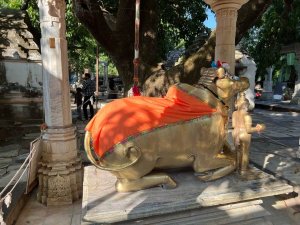
The temple has several small shrines dedicated to Shiva’s mount, Nandi, made of panchadhatu an alloy used for making idols, which is composed of five metals – gold, silver, copper, brass and zinc. The inscription on the Nandi is dated 1407 CE and a statue of the famous 16th century Charan poet stands next to it with an inscription dated 1629 CE. According to local legend, the statue of Nandi is credited with protecting the temple from an attack of Muslim invaders by releasing innumerable bumble bees that stung the attackers thereby saving the temple from destruction. The temple also has several other idols, sculpted from sphatik,a type of quartz which appears opaque in natural light but becomes translucent when a light is held against it.

We then made our way by jeep to the Achalgarh Fort which rises loftily above the temple and was built in the 14th century by Maharana Kumbha (1417–1468), the ruler of the Kingdom of Mewar, and it was during his reign that Mewar became one of the most important states in Northern India.
Daivat then very kindly presented us with a book for the library, ‘The Abu Chronicles’ by Narendra Patel and took his leave. He later sent a wonderful sweet to the hotel for our pudding.
Day 4
Those who were brave enough ventured forth in the early morning to the site of the Gaumuk Temple (literally means the mouth of a cow) dedicated to Saint Vashishtra who performed a yagna, a ritual in front of a sacred fire, at this place creating the four Rajput clans. The challenge involved climbing down some 750 steps and then up again. Later in the afternoon, we made our way around Nakki Lake which Tod did not have time to visit. Today, it appears to be a great honeymoon destination given the numerous signs marking good spots for photographs.
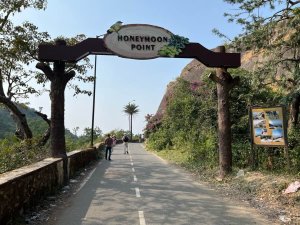
We then ended the day at St. Saviour’s Cemetery (formerly St.Lawrence’s) and two very kind men brought us the keys so we could enter. Liz had tried last time but the keyholders could not be found. Here, we found the grave of Honoria Lawrence (1808-1854) who is known for her diaries describing her life in India as the wife of a British official and that of Francis Younghusband’s infant son. The graveyard appeared to be fairly well kept although several of the graves were understandably overgrown.
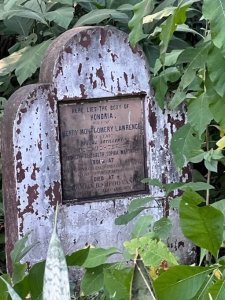 Tomorrow we go to Ahmedabad!
Tomorrow we go to Ahmedabad!
Dr Alison Ohta (RAS Director), 19 November 2024.

